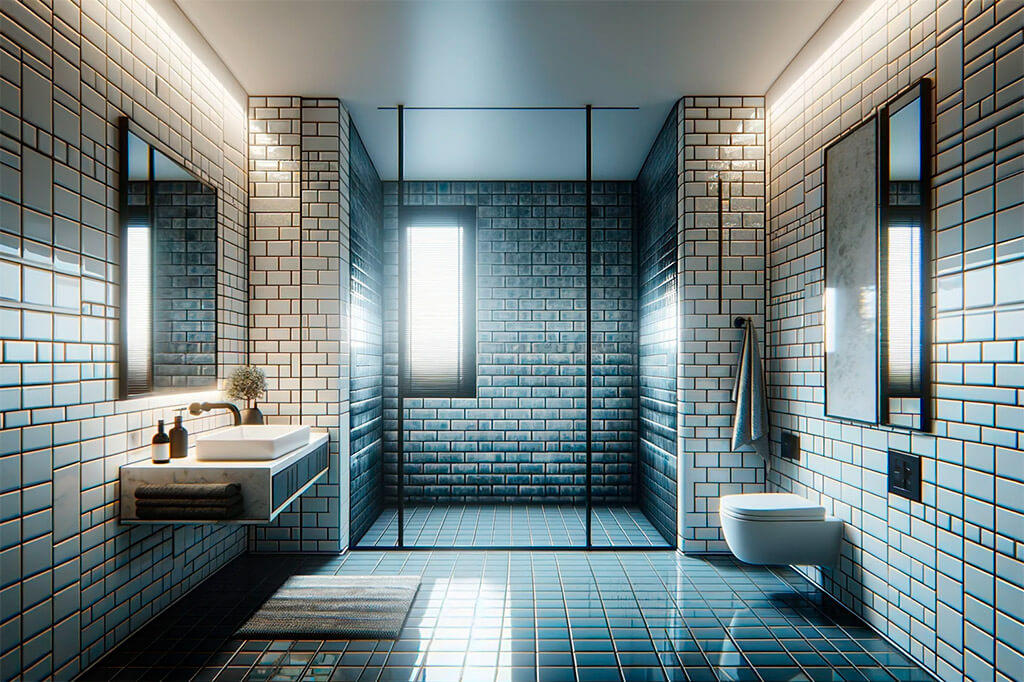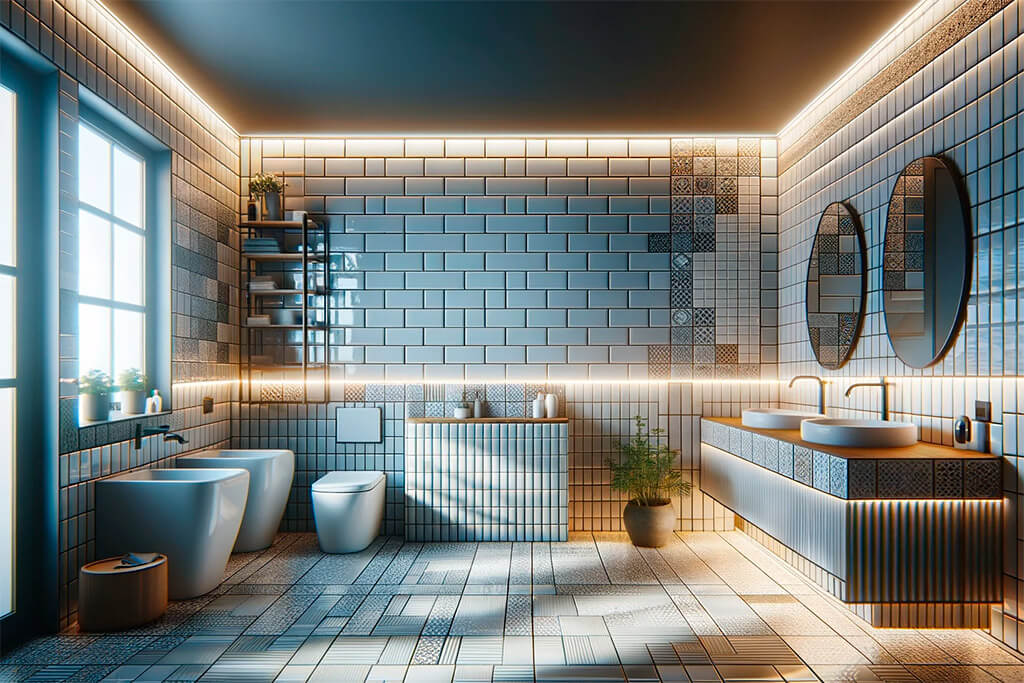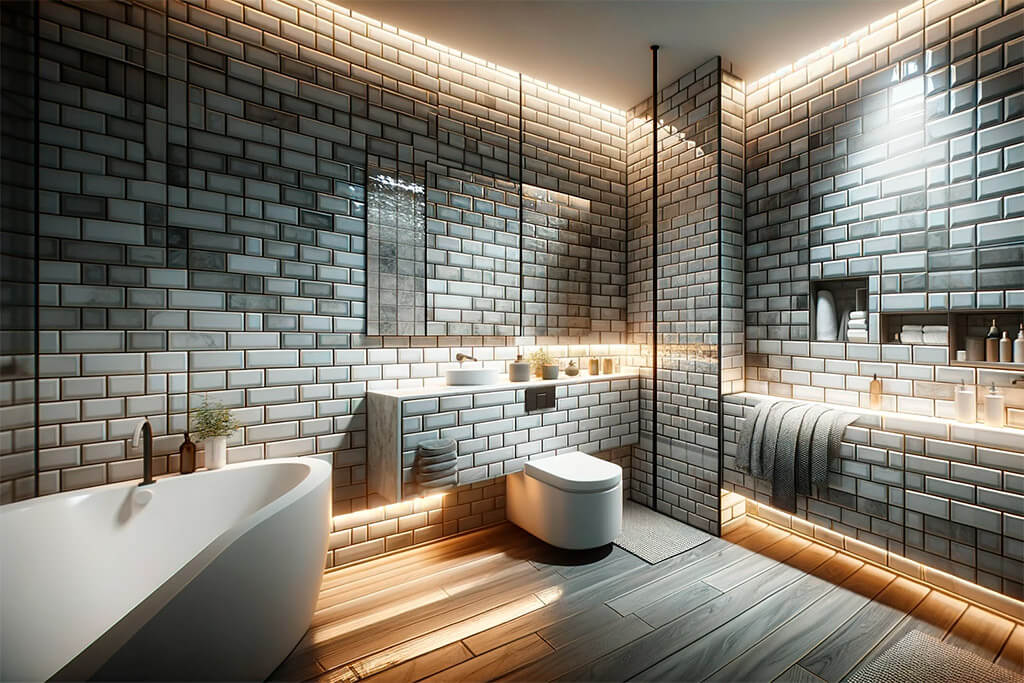Subway tiles, those timeless rectangular beauties, first graced the walls of New York City’s subterranean transit stations over a century ago. Their resilience and ease of cleaning quickly made them a staple in American architecture. Nowadays, these classics are enjoying a resurgence, finding their way into modern home designs, particularly bathrooms.
This guide is crafted for the industrious souls in home renovation – the DIY enthusiasts and independent contractors across the USA. Whether you’re tackling a full-scale remodel or a weekend update, subway tiles can be your best ally.

The Timeless Appeal of Subway Tiles
Subway tiles have stood the test of time, consistently remaining a favorite in bathroom design. What’s their secret? Flexibility. These tiles bridge the gap between traditional charm and contemporary chic. Their simple, rectangular shape offers a versatile canvas for any style, be it a classic 1920s feel or a sleek, modern ambiance.
Modern Subway Tile Bathroom Concepts
Modern subway tile designs are all about creativity and personal expression. These aren’t just background elements, they’re focal points. Here’s how you can bring a contemporary twist to these traditional tiles:
- Color Play: Depart from the classic white. Consider charcoal, navy, or even terra cotta for a bold statement.
- Finish and Texture: Matte finishes or handcrafted textures can add depth and interest.
- Innovative Patterns: Lay tiles in a herringbone, basketweave, or vertical stack to create visual intrigue.
- Mix and Match: Combine different colors or sizes for a unique mosaic effect.
Remember, the key to a successful modern design lies in balancing innovation with harmony.

Subway Tile Shower Ideas
In the shower, subway tiles are more than just a practical choice, they’re an opportunity to craft an oasis. Here’s where you can really flex your creative muscles:
- Pattern Play: Classic offset, vertical, diagonal – the options are endless.
- Grout Lines: Grout color can dramatically alter the look. Go for contrast to highlight the pattern or a matching color for a subtle, unified appearance.
- Accent Tiles: Consider using accent tiles for a pop of color or an artistic touch.
- Niche and Borders: Create niches or borders with contrasting tiles for functional beauty.
With subway tiles, your shower can transform from a mere functional space into a personalized retreat.
Choosing the Right Subway Tile for Your Bathroom Floor
When selecting subway tiles for your bathroom floor, you’re looking for a balance of durability and safety, alongside aesthetic appeal. In my years of experience, I’ve learned that not all tiles are created equal, especially when it comes to flooring. Here’s how to make a wise choice:
- Opt for Durability: Always choose tiles specifically rated for floor use. These are designed to withstand regular foot traffic and the occasional mishaps of dropped items.
- Slip Resistance is Crucial: Bathrooms are prone to water spills, so your tiles need to offer a safe, slip-resistant surface. Tiles with a matte finish or slight texture can provide that necessary grip.
- Consider Tile Size: Larger tiles can give a modern, spacious feel to a bathroom, but remember, they may become slippery. Smaller tiles, with more grout lines, offer increased slip resistance.
Pro tip: For a blend of style and functionality, experiment with different tile sizes and colors. A classic example is a checkerboard pattern or a contrasting color border, adding both visual interest and practicality.

White Bathroom Tile: A Classic Choice
White subway tiles have a timeless appeal, much like a blank canvas, offering a backdrop for a variety of design choices. Here’s how to make the most out of these classic tiles:
- Experiment with Layouts: Moving beyond the traditional brick layout opens up numerous design possibilities. Vertical stacking or herringbone patterns can add a contemporary touch.
- Grout as a Design Element: The choice of grout color can significantly impact the overall look. Dark grout can create a striking, graphic effect, while lighter grout offers a more subtle and unified appearance.
- Incorporate Accent Tiles: Interspersing colored or textured tiles can break up the monotony, adding unique flair to your design.
Integrating Subway Tiles into the Overall Bathroom Design
Achieving a cohesive bathroom design with subway tiles requires thoughtful planning and an eye for detail. Here’s how to ensure a harmonious integration:
- Harmonize with Color: Select tiles that either complement or offer a pleasing contrast to your fixtures. For example, tiles in warm tones can complement brass fixtures beautifully.
- Consider Proportions: In smaller bathrooms, larger tiles can create an illusion of space. Conversely, in larger bathrooms, the use of smaller tiles can add intricate detail and texture.
- Smooth Transitions: If you’re combining different tiles on walls and floors, ensure a seamless transition. Using a border tile where they meet or continuing wall tiles onto the floor for a short stretch can create a unified look.
In tile work, precision and planning are everything. I recommend laying out your tile pattern before installation to envision the end result. This step ensures not only a functional but also a visually appealing outcome.
DIY Tips and Tricks for Subway Tile Installation
Installing subway tiles is a task that, while straightforward, requires attention to detail and the right approach. Here’s a step-by-step guide:
- Surface Preparation: A smooth, clean surface is crucial. Any imperfections can affect the tile alignment and adherence.
- Essential Tools: You’ll need a notched trowel for adhesive application, spacers for even tile spacing, a level to ensure straight lines, a tile cutter for precise cuts, and the appropriate adhesive and grout.
- Starting Off: Whether you begin in the center or at one end (especially for staggered patterns), it’s important to apply adhesive evenly and place the first tile carefully.
- Maintaining Level: Regular checks with a level are important to avoid uneven tile lines.
- Cutting Tiles: Accurate measurements and careful cutting are vital for a professional finish, especially around obstacles like outlets.
- Grouting: After the adhesive sets, apply grout thoroughly, filling all spaces and removing excess for a clean look.
FAQ Section
The size of the tile should complement the size of the bathroom. Larger tiles can create a sense of space in smaller bathrooms, while smaller tiles are suitable for larger spaces or creating detailed patterns.
Yes, but ensure they have a matte or textured finish for slip resistance. It’s essential for safety in wet areas like bathrooms.
Ceramic subway tiles are a cost-effective choice. They offer a wide range of colors and finishes without breaking the bank.
Light-colored tiles can make a room feel more spacious. Vertical tile placement can also create an illusion of height, making the bathroom appear larger.
